Radar Technology Encyclopedia
(Electronic Edition)
David K. Barton
Sergey A. Leonov
Editors
Artech House
Boston•.London
�
iv
Library of Congress Cataloging-in-Publication Data
Barton, David K.
Radar technology encyclopedia / David K. Barton and Sergey A. Leonov, editors
Includes bibliographical rteferences and index
ISBN 0-89006-893-3
1. Radar—Encyclopedias.
II. Leonov, S. A. (Sergey Alexandovich).
I. Barton, David Knox, 1927-.
TK6574.R34 1997
621.3848’03—dc21
96-52026
CIP
British Library Cataloguing in Publication Data
Radar technology encyclopedia
1 Radar- encyclopedias
I. Barton, David K. (David Knox)
ISBN 0-89006-893-3
II. Leonov, Sergey A.
© 1998 ARTECH HOUSE, INC.
685 Canton Street
Norwood, MA 02062
All rights reserved. Produced in United States of America. No part of this book may be reproduced or
utilized in any form or by any means, electronic or mechanical, including photocopying, recording, or
by any information storage and retrieval system, without permission in writing from the publisher.
All terms mentioned in this book that are known to be trademarks or service marks have been appro-
priately capitalized. Artech House cannot attest to the accuracy of this information. Use of a term in this
book should not be regarded as affecting the validity of any trademark or service mark.
International Standard Book Number: 0-89006-893-3
Library of Congress Catalog Card Number: 96-52026
�
v
ix
Contributors
ix
About the Authors
Introduction
xi
Use of Hypertext Links xii
A
absorber, radar
absorption
accuracy
acquisition
adapter, microwave
algorithm
aliasing
altimeter, radar
ambiguity
ambiguity function
amplifier, microwave
amplitron
amplitude
analyzer
anechoic chamber
angel (echo)
angle
antenna
aperture
approximation
array (antenna)
astronomy, radar
atmosphere
atmospherics
attenuation
attenuator
autocorrelator
autodyne
availability
axis
B
backscatter, backscattering
backward-wave tube
band
bandwidth
bang, main
baseband
baseline
beam, antenna
bel
bimatron
bitermitron
blanking, blanker
blinking
blip
blocking
blooming
Boltzmann’s constant
boresighting
Bragg
bridge, microwave
burnthrough
buoy, radar
C
calibration
camouflage
cancellation, canceler
capture effect
1
5
5
7
8
8
10
10
11
12
15
22
22
22
22
23
23
25
40
41
42
51
51
55
55
58
59
59
59
60
60
60
61
61
62
62
62
62
64
64
64
64
64
65
65
65
65
65
65
65
67
67
67
68
68
72
Table of Contents
carcinotron
cathode-ray tube
cell, radar (resolution)
centroiding
cepstrum
chaff
channel
chart
chirp
choke, microwave
circuit
circulator
clipping
clutter
coast
coaxitron
code, coding
coherence
conductance
confusion area
connector, microwave
conopulse
constant false alarm rate
contrast, radar
control
conversion, converter
convolution
coordinates, radar
correlation function
correlator
Cotton-Mouton effect
coupler, directional
coverage, radar
crossed-field amplifier
crowbar
D
data, radar
deception, radar
decibel
decoder
decorrelation
decoy, radar
defruiter
delay
delay line
delta [Dirac] function
dematron
demodulation
demultiplexing
depolarization
depth of focus
designation
detectability factor
detection [of radar targets]
detector [demodulation, demodu-
lators[
device, microwave
diagram
Dicke fix
dielectric
diffraction
diode, microwave
diplex (mode)
dipole
direction finder, direction finding
discrimination, discriminator
72
72
73
73
74
74
74
75
76
76
76
77
78
78
88
88
88
90
91
91
91
91
91
93
93
94
96
96
97
98
98
99
100
101
103
104
105
105
106
106
106
106
107
107
111
111
111
111
111
112
112
112
113
125
129
132
132
133
133
133
137
137
137
138
display, radar
distribution
diversity
divider
doppler effect
drive
duct, ducting
duplexer
duty factor
dynamic range
E
eclipsing
echo, radar
effective echoing area
electromagnetic compatibility
(EMC)
electronic counter- counter mea-
sures ECCM)
electronic countermeasures
(ECM)
electronic intelligence
electronic (warfare) support mea-
sures (ESM)
electronic warfare
equalization
equivalence principle
error, measurement
exciter
F
fading
failure
false alarm
fantastron
Faraday
feed, antenna
feedback
feeder [feed line]
fence
ferrite
field, electromagnetic
filter, filtering
fluctuation
follower
frequency
Friis transmission formula
“fruit”
function, random
fuze, radar
G
gain
garble
gate, gating
generator
ghost
glint
goniometer
“grass”
guidance, radar
gull
Gunn effect
gyrotron
139
146
149
149
149
151
151
151
152
153
153
154
154
154
154
156
161
162
162
163
163
164
172
173
173
173
174
175
175
180
180
180
181
181
182
197
197
197
203
203
203
204
204
205
205
206
207
207
207
207
207
208
208
208
�
vi
H
height finder
heterodyning
hit
hole, radar
hologram, holography, radar
homing, radar
horizon, radar
Huygens’ source
hybrid (junction), microwave
I
illuminator
image, imaging, radar
impedance
inductance
information measure
integrated circuit
integration, integrator
intelligence, radar
interference
interferometer, radar
interpolation
interrogation, interrogator
intrusion
ionosphere
iris, matching
J
K
jaff
jammer, jamming
jitter
joint, microwave
Josephson effect
Kabanov effect
klystron
L
lens
likelihood
limiter
line
load
lobe
local oscillator (LO)
loss, in radar
M
magnetron
map
mapping
mark, calibration
matrix
measurement, radar
meteorology, radar
microphone effect
missile, antiradiation
mixer
model
modulation
modulator
monopinch
monopulse
moving target detector
moving target indication
multiport, microwave
multivibrator
209
210
210
210
210
213
213
213
213
214
214
216
217
217
217
219
223
223
223
223
224
224
224
225
225
225
231
232
232
232
232
234
237
238
240
240
240
241
243
258
262
262
263
263
264
265
266
266
266
269
269
271
274
275
278
279
283
283
N
O
navigation, radio
navigator, doppler
network
noise
nomenclature, radar
notcher
nuclear effects
nulling
Nyquist ‘
operator, radar
oscillation
oscillator, microwave
P
parametric echo effect
pattern, antenna
performance, radar
permeability
permittivity
phase
phase shifter
phasor
platform
platinotron
plumbing
Poincaré sphere
polarization
polarizer
polyplexer
potential, radar
power
Poynting(’s) vector
precision
preclassification
principle
propagation, wave
pulse
pulse compression
pulse repetition frquency (PRF)
pulser
Q
Q(-factor)
Q-function
Quantization
R
(running) rabbits
radar
radar applications and types
radar cross section
radargrammetry
radiation
radiator, radiating elements, of
antenna
radiometer, radiometry, micro-
wave
radome
railing
range
range equation
range finder, ranging, radar
receiver, reception, radar
reciprocity
reflection
reflectivity
reflectometer
reflector
refractivity
relay, radar
reliability, radar
repair
resistance
resolution
resonator, microwave
response
return loss
ring
S
sample, sampling
scan, scanning
scanner, antenna
scatterer, scattering
scatterometer
sea effect
searchlighting
seeker, radar
selectivity
sensitivity
sequence
service, radar
sextant, radar
shadow, radar
shift keying
sidelobe
sight, radar
signal, radar
signal processing, signal proces-
sor
silence, radar
skiatron
slant-range effect
slow-wave structure
smoothing, data
speckle
spectrometer, spectroscopy, radar
spectrum
speed, blind
spoofing
squitter
stabilitron
stability
stealth
step function
strobe
subsystem, radar
superposition
suppression
surveillance, radar
switch, switching
synchronizer
synthesizer
T
tapering
target, radar
target recognition and identifica-
tion
temperature, noise
test, testing, radar
tetrode
threshold
throughput capability
thyristor
time
tomography, microwave
track, trackers, tracking
tradeoff
trainer, radar
284
285
286
286
288
289
289
290
290
290
290
291
296
296
299
299
300
300
300
304
304
304
304
304
304
307
307
307
307
310
310
310
310
310
313
315
318
319
320
320
320
320
320
321
361
370
371
372
373
374
376
376
378
385
387
393
393
395
396
396
400
400
400
400
401
401
404
408
408
408
408
409
411
414
415
416
416
416
418
418
418
419
420
420
420
420
421
421
424
425
425
425
425
426
426
426
426
427
427
427
427
427
428
428
428
428
428
429
429
429
429
429
430
430
432
436
438
439
439
439
440
440
441
441
445
446
�
vii
transceiver
transducer
transfer function
transform
transformer, microwave
transistor, microwave
transmission line, microwave
transmissivity
transmitter, radar
transponder
traveling-wave tube (TWT)
trigatron
trigger (flip-flop) circuit
triode, microwave
troposphere
tube, microwave
twystron
446
446
446
446
449
450
452
456
456
459
460
462
462
462
462
463
465
U
V
uncertainty
varactor
varicap
vaxitron
vegetation factor
velocity
velodyne
video
visibility
W
wave, electromagnetic
waveform, radar
waveguide
weighting
zone, radar
X
Y
Z
Alphabetical Bibliography
Bibliography by Subject
Radar Abbreviations and Acro-
nyms
465
466
466
466
466
466
466
466
467
468
472
478
483
484
485
503
507
�
ix
CONTRIBUTORS
Barton, David K., Vice President, ANRO Engineering (U.S.A.), contributed as editor and author.
Barton, William F., Consulting Engineer, PictureTel (U.S.A.), contributed as translator.
Hamilton, Paul C., Vice President, ANRO Engineering (U.S.A.), contributed as author.
Leonov, Alexander I., Professor, Moscow Institute of Technology (Russia), contributed as author.
Leonov, Sergey A., Senior Engineer, Raytheon Canada Limited (Canada), contributed as editor,
author, and translator.
Michelson, Max, Senior Research Scientist, ANRO Engineering (U.S.A.), contributed as translator.
Morozov, Illya A., Senior Research Scientist, Aerospace Research Institute (Russia), contributed as
author.
ABOUT THE AUTHORS
Mr. David K. Barton is a well-known radar expert, lecturer,
and author of several fundamental radar books published in
the United States, United Kingdom, Russia, China, and many
other countries. Mr. Barton has had a long career in radar,
including service with the U.S. Army Signal Corp., RCA,
Raytheon, and currently as Vice President for Engineering
with ANRO Engineering, Inc. He is an author of Radar Sys-
tems Analysis (Prentice-Hall, 1964; Artech House, 1976)
Modern Radar System Analysis (Artech House, 1988), coau-
thor (with H. R. Ward) of Handbook of Radar Measurement
(Prentice-Hall, 1969; Artech House, 1984), with W. F. Barton
of Modern Radar System Analysis Software (Artech House,
1993), with C. E. Cook and P. C. Hamilton of Radar Evalua-
tion Handbook (Artech House, 1991), and editor of Radars
(Artech House, 1975). Mr. Barton is an editor of Artech
House Radar Library, and a Fellow of the IEEE. His contribu-
tion to the Encyclopedia is identified by the initials DKB fol-
lowing the article.
Dr. Paul C. Hamilton is a leading expert on radar and sys-
tems design. He has much experience having served with the
U.S. Air Force, Hughes Aviation Co., and Raytheon and now
as Vice President for Radar Studies with ANRO Engineering,
Inc. He is coauthor (with D. K. Barton and C. E. Cook) of the
Radar Evaluation Handbook (Artech House, 1991). His con-
tribution to the Encyclopedia is identified by the initials PCH
following the article.
Dr. Alexander I. Leonov is well known in Russia as a scien-
tist and engineer in the field of radar. For about 25 years he
was a senior member of teams that designed and tested state-
of-the-art radars for Soviet ABM programs, and now he is a
professor at the Moscow Institute of Technology. He is an
author of Radar in Anti-Missile Defense (Voenizdat, 1967),
coauthor (with K. I. Fomichev) of Monopulse Radar (Soviet-
skoe Radio, 1970, 1984; trans. Artech House 1986), and
coauthor and editor of Modeling in Radar (Sovietskoe Radio,
1979) and Radar Test (Radio i Svyaz, 1990). He holds the
academic rank of professor and “All-Russian Honorable” title
in the field of science and engineering. His contribution to the
Encyclopedia is identified by the initials AIL following the
article.
Dr. Sergey A. Leonov is known in both Russia and the West
as a bilingual radar expert. He started his radar career work-
ing for Russian space programs; later he designed and tested
shipborne and spaceborne radars, headed a research labora-
tory in Moscow Aerospace Institute, and currently is with
Raytheon Canada Limited. He is an author of Air Defense
Radars (Voenizdat, 1988), coauthor (with A. I. Leonov) of
Radar Test (Radio i Svyaz, 1990), and (with W. F. Barton) of
the Russian-English and English-Russian Dictionary of
Radar and Electronics (Artech House, 1993). He holds the
academic rank of associate professor, “All-Russian Honor-
able” title in the field of science and engineering, and a Senior
Member of IEEE. His contribution to the Encyclopedia is
identified by the initials SAL following the article.
Dr. Ilya A. Morozov is a leading Russian expert on radar and
microwave technology. He has participated in a series of pro-
grams involving design and test of Russian state-of-the-art
phased-array radars, and currently is a Senior Research Scien-
tist at the Moscow Aerospace Institute. Dr. Morozov is a
coauthor of a book Ships of National Control (Moskovskiy
Litsey, 1991), and Sophisticated Radio Systems Performance
Estimation (Mashinostroenie, 1993). His contribution to the
Encyclopedia is identified by the initials IAM following the
article.
�
xi
INTRODUCTION
The Radar Technology Encyclopedia is a joint product of
leading United States and Russian radar experts with decades
of experience on design, development, and test of state-of-
the-art radar systems and technology. The Encyclopedia cov-
ers the entire field of radar fundamentals, design, engineering,
systems, subsystems, and major components. It contains
about 5000 entries, each giving the depicted term definition,
and, if applicable, the standard notation, brief description,
evaluation formulas, relevant block diagrams, performance
summary, and a reference to the literature in which the more
detailed information is available. The purpose is to provide,
in a single volume, the reference material for researchers and
engineers in radar and related disciplines, representing the
most modern information available in both the former Soviet
Union and in the West. It includes an extensive bibliography
of sources from both regions. This bibliography covers practi-
cally all monographs and textbooks in radar and related sub-
jects published after World War II in English (in the U.S.A.
and England) and Russian (in the former Soviet Union) lan-
guages that covers the overwhelming majority of the world-
wide library of radar books.
The Encyclopedia format is alphabetical by subject. It
consists of top-level articles, which are identified with bold
capital letters (e.g., MAGNETRON), and, if applicable, are
followed by subarticles, which are identified in lowercase
bold (e.g., rising-sun magnetron). The top-level articles are
arranged in the way so the key word (typically, a noun) deter-
mines its alphabetical position (e.g., microwave antenna is
cited as ANTENNA, microwave, radar targets as TARGET,
radar, data smoothing as SMOOTHING, data). Subarticles
within a top-level article are given in a conventional word
order typically used in literature and alphabetically arranged,
for example:
AMPLIFIER, microwave
amplifier-attenuator
amplifier chain
aperiodic amplifier
backward-wave tube amplifier
balanced amplifier
bandpass amplifier
and so forth.
The subarticles are alphabetized without regard to
whether the qualifying adjective precedes or follows the main
word: broadband antenna precedes antenna control.
Within each article and subarticle, if applicable, the
cross-reference to another subarticle is indicated in lower-
case bold, e.g.:
“The RCS of this type of clutter is calculated using the
volume of the clutter cell Vc and the volume reflectiv-
ity h
v (see volume clutter). “
That subarticle is found alphabetically within the same top-
level article, e.g., CLUTTER. If the cross-reference refers to
another top-level article, then the name of this article is given
in capital letters. For example, a reader is referred to an article
NOISE, and will find that article alphabetically under N.
Parentheses in the name of an article or subarticle mean
that the word is optional. For example, phased array
(antenna) means that the term is used both as phased array
or phased array antenna. Square brackets mean that the
word in the brackets can be used instead of the previous one.
For example, bed of spikes [nails] ambiguity function
means that the term is used as bed of spikes ambiguity func-
tion or bed of nails ambiguity function.
For definitions of terms, extensive use has been made of
IEEE Standard Dictionary of Electrical and Electronics
Terms and IEEE Standard Radar Definitions. The standard
definitions reproduced from these dictionaries and other
acknowledged sources are put into quotes. The Encyclopedia
does not contain separate articles with the description and
performance of concrete radar stations and facilities, because
even brief description of the major radars developed through-
out the world requires to provide additional volume as thick
as this one. This information is systematized in Jane’s Radar
and Electronic Warfare Systems, updated and issued annually,
and the Encyclopedia does not duplicate this material. How-
ever, where applicable, extensive examples of modern radars
are provided.
�
xii
Each article and subarticle contains references, primarily
to textbooks, which are listed alphabetically by author in the
Alphabetical Bibliography at the end of Encyclopedia. The
combination of the surname of the first author and a year of
edition identifies the cited book:
Ref.: Skolnik (1980)
refers to the book listed in the bibliography as:
Skolnik, M. I., Introduction to Radar Systems, McGraw-
Hill, 1980;
and the brief reference:
Ref.: Barton (1969)
identifies the book listed with both authors and two editions
or publishers:
Barton, D. K., and Ward, H. R., Handbook of Radar Mea-
surement, Prentice-Hall, 1969; Artech House, 1984.
In rare cases where there is no applicable textbook, reference
is made to a professional journal article. Typically, each arti-
cle is followed by references to the major current books, as
listed in the Alphabetical Bibliography, and for the readers
interested in a full bibliography on a corresponding subject
the Bibliography by Subject is provided. It contains a full bib-
liography list of the identifiable radar and radar-related books
published during the last 50 years and is arranged in 35 sec-
tions by subject. Within each section the books are given in
chronological order, and alphabetically by author within one
year. At the end of Encyclopedia is a list of the most common
radar abbreviations and acronyms.
The author of each article and subarticle is identified by
the corresponding initials following the entry, when that entry
exceeds a few lines of definition (see About the Authors). The
original generation of the list of entries, compiling of the Bib-
liography, and final editing of Encyclopedia material was
done by David K. Barton and Sergey A. Leonov.
David K. Barton and Sergey A. Leonov,
Editors
Use of Hypertext Links
In this electronic edition of the Radar Technology Ency-
clopedia, hypertext links have been added to transfer rapidly
from one article to a related or referenced subject. The words
or phrases from which links can be exercised appear in blue
text. Clicking on any blue entry initiates an immediate trans-
fer to the related entry. The program keeps track of the history
of these transfers, and the reader can retrace steps by clicking
in either the right or left page margins.
�
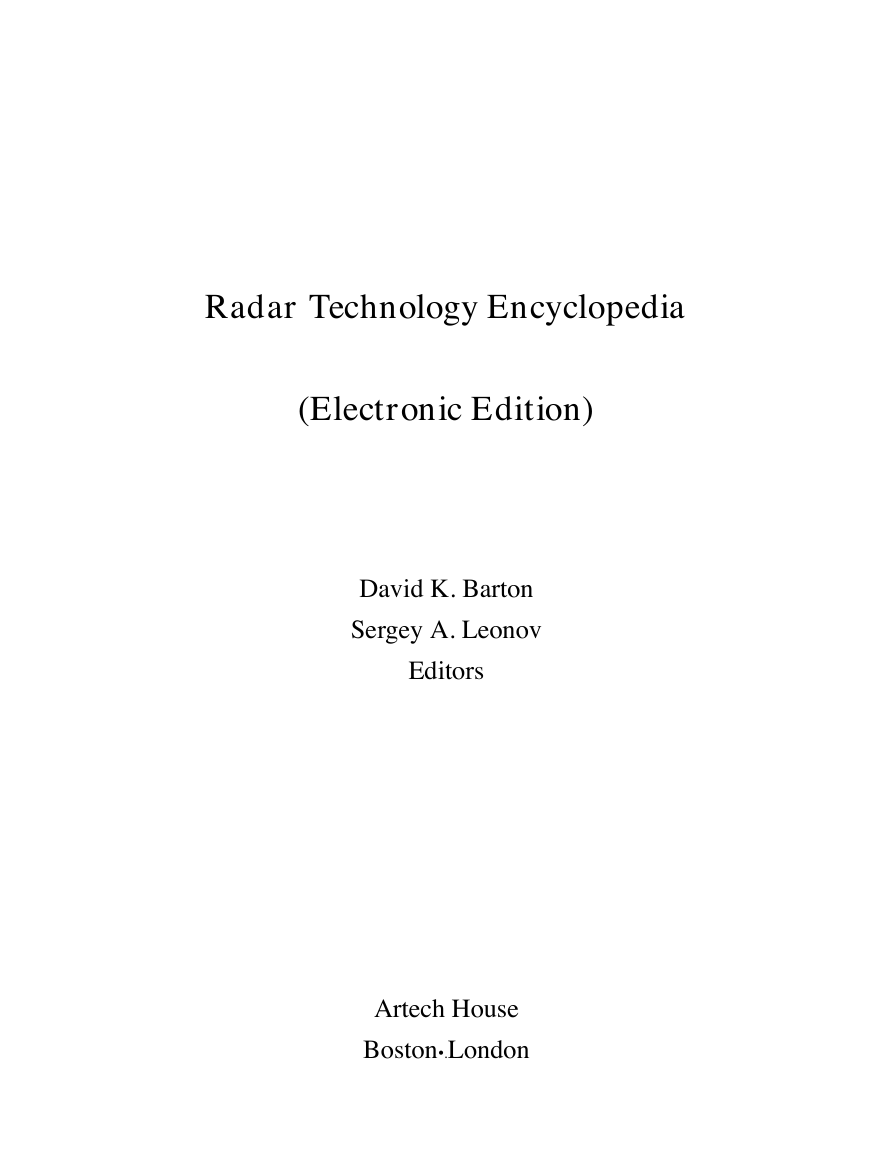

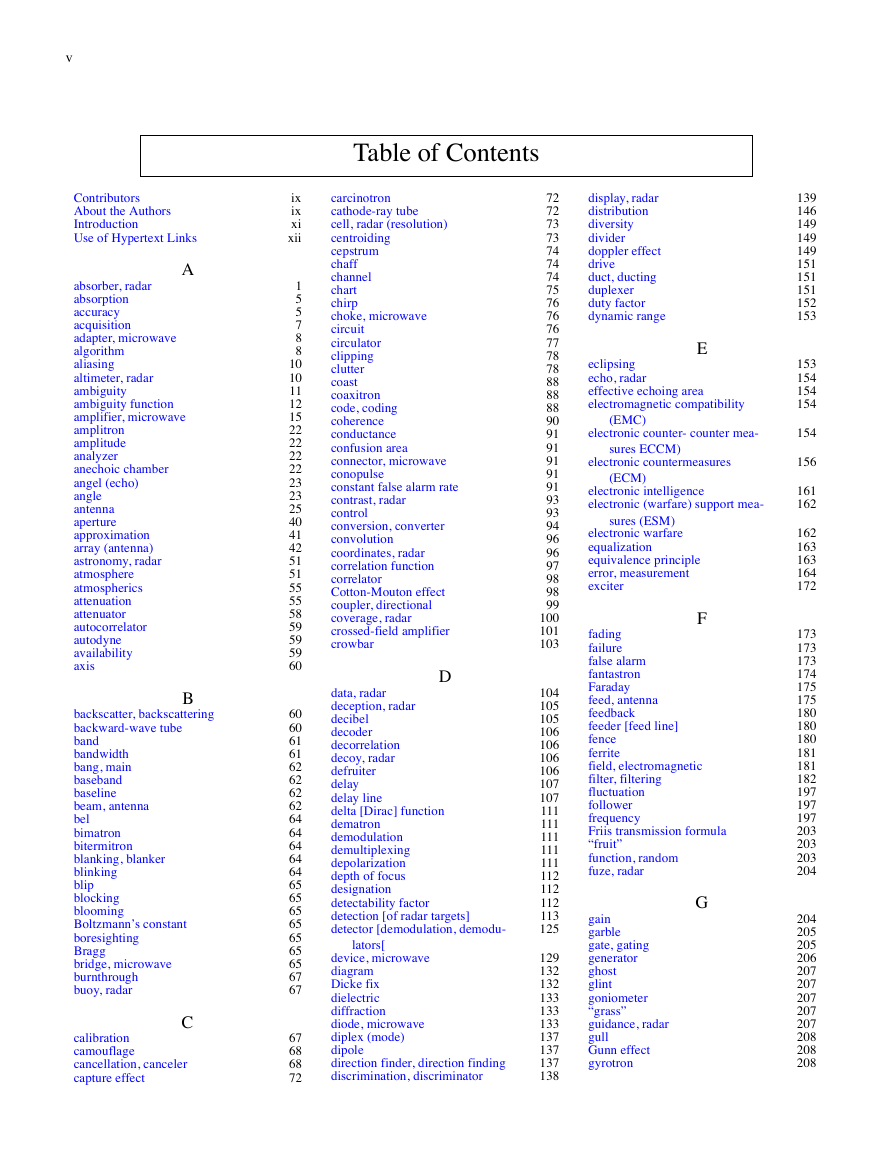
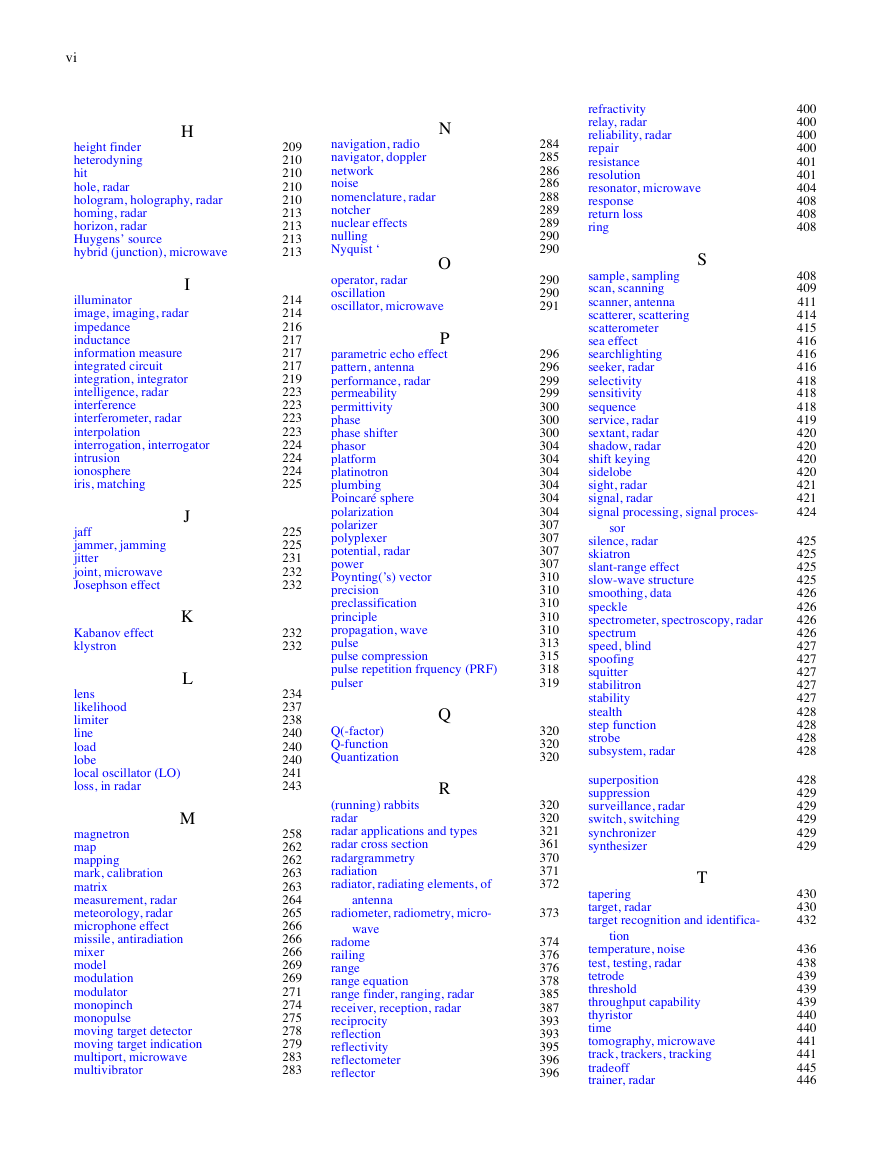

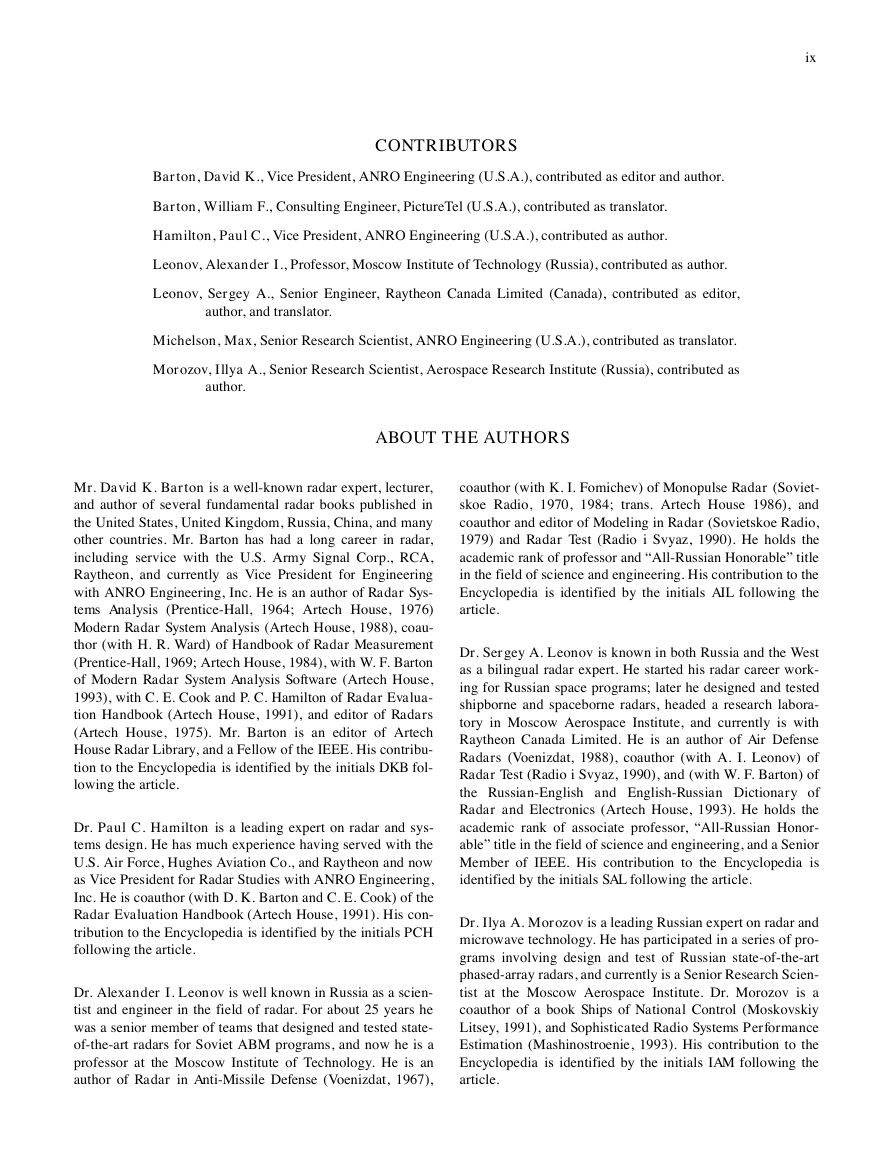
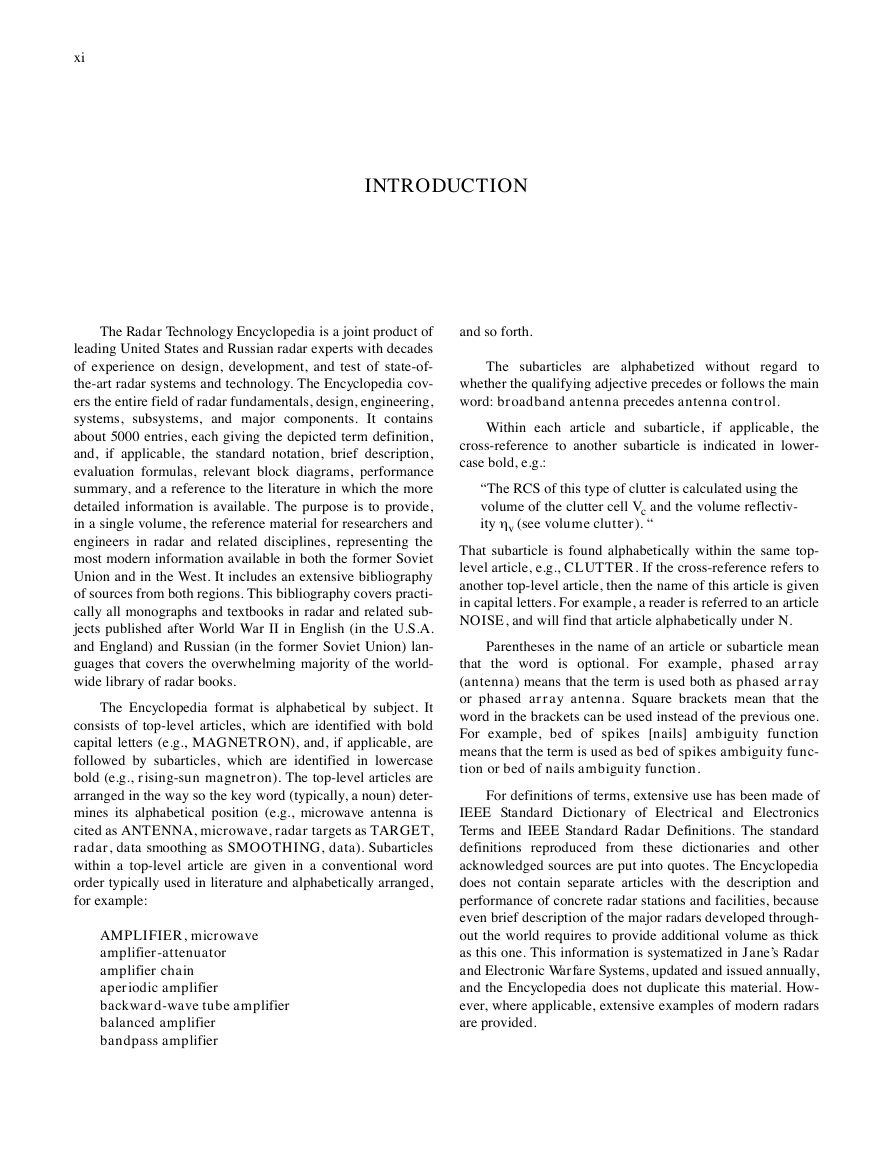
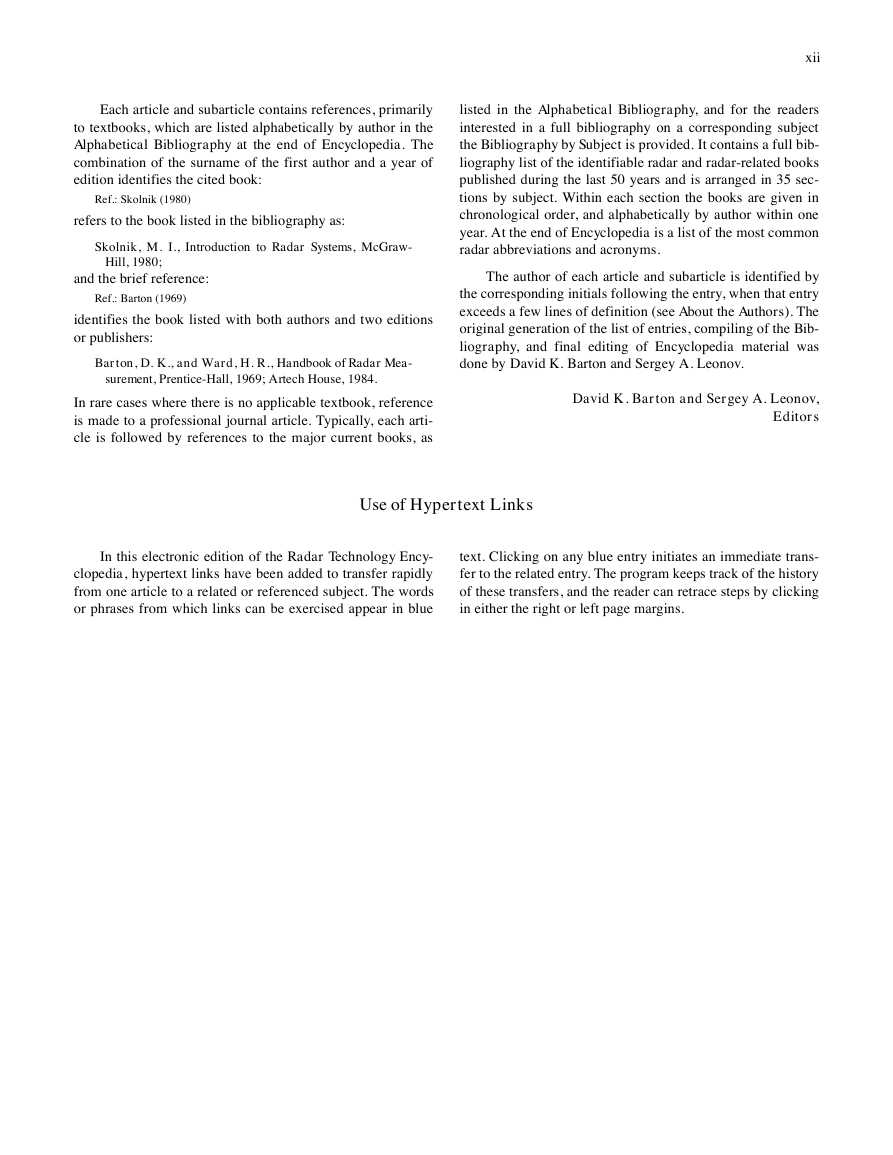








 2023年江西萍乡中考道德与法治真题及答案.doc
2023年江西萍乡中考道德与法治真题及答案.doc 2012年重庆南川中考生物真题及答案.doc
2012年重庆南川中考生物真题及答案.doc 2013年江西师范大学地理学综合及文艺理论基础考研真题.doc
2013年江西师范大学地理学综合及文艺理论基础考研真题.doc 2020年四川甘孜小升初语文真题及答案I卷.doc
2020年四川甘孜小升初语文真题及答案I卷.doc 2020年注册岩土工程师专业基础考试真题及答案.doc
2020年注册岩土工程师专业基础考试真题及答案.doc 2023-2024学年福建省厦门市九年级上学期数学月考试题及答案.doc
2023-2024学年福建省厦门市九年级上学期数学月考试题及答案.doc 2021-2022学年辽宁省沈阳市大东区九年级上学期语文期末试题及答案.doc
2021-2022学年辽宁省沈阳市大东区九年级上学期语文期末试题及答案.doc 2022-2023学年北京东城区初三第一学期物理期末试卷及答案.doc
2022-2023学年北京东城区初三第一学期物理期末试卷及答案.doc 2018上半年江西教师资格初中地理学科知识与教学能力真题及答案.doc
2018上半年江西教师资格初中地理学科知识与教学能力真题及答案.doc 2012年河北国家公务员申论考试真题及答案-省级.doc
2012年河北国家公务员申论考试真题及答案-省级.doc 2020-2021学年江苏省扬州市江都区邵樊片九年级上学期数学第一次质量检测试题及答案.doc
2020-2021学年江苏省扬州市江都区邵樊片九年级上学期数学第一次质量检测试题及答案.doc 2022下半年黑龙江教师资格证中学综合素质真题及答案.doc
2022下半年黑龙江教师资格证中学综合素质真题及答案.doc